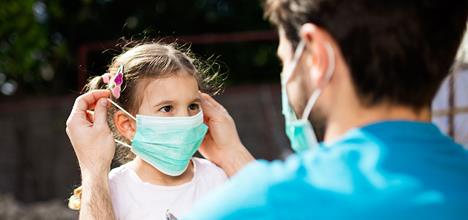

To protect ourselves and others from COVID-19, the CDC now recommends cloth face coverings be used when outside. But what about children? Read on for answers to some frequently asked questions about cloth face coverings and children during the COVID-19 pandemic.
Since so many people who have COVID-19 don’t have symptoms, wearing cloth face coverings reduces the chance of transmitting the virus through the spray of spit or respiratory droplets. This is especially true for when someone with COVID-19 comes within 6 feet of you, which is the range of transmitting infection through acts like sneezing or coughing.
Children under the age of 2 years should not wear cloth face coverings.
There are places where children should wear cloth face coverings. This includes places where they may not be able to avoid staying 6 feet away from others. For example, if you have to take them to the doctor, pharmacy, or grocery store.
However, there are other places where children do NOT need to wear a cloth face covering:
Caution: you may need to reconsider the use of cloth face coverings if:
Staying home and physical distancing is still the best way to protect your family from COVID-19. Especially for younger children who may not understand why they can’t run up toward other people or touch things they shouldn’t, it’s best to keep them home. Children who are sick (fever, cough, congestion, runny nose, diarrhea, or vomiting) should not leave home.
It’s understandable that children may be afraid of cloth face coverings at first. Here are a few ideas to help make them seem less scary:
For children under 3, it’s best to answer their questions simply in language they understand. If they ask about why people are wearing cloth face coverings, explain that sometimes people wear them when they are sick, and when they are all better, they stop wearing them.
For children over 3, try focusing on germs. Explain that germs are special to your own body. Some germs and good and some are bad. The bad ones can make you sick. Since we can’t always tell which are good or bad, the cloth face coverings help make sure you keep those germs away from your own body.
One of the biggest challenges with having children wear cloth face coverings relates to them “feeling different” or stereotyping them as being sick. As more people wear these cloth face coverings, children will get used to them and not feel singled out or strange about wearing them.
Yes. Place the cloth face covering securely over the nose and mouth and stretch it from ear to ear. Remember to wash your hands before and after you wear it and avoid touching it once it’s on your face. When back inside, avoid touching the front of the face covering by taking it off from behind. Cloth face coverings should not be worn when eating or drinking.
Wash cloth face coverings after each wearing.
Homemade or purchased cloth face coverings are fine for most people to wear. For children, the right fit is important. Pleated face coverings with elastic are likely to work best for kids. Adult cloth face coverings are usually 6×12 inches, and even a child-sized 5×10 inch covering may be too large for small children. Try to find the right size for your child’s face and be sure to adjust it for a secure fit.
Due to very limited supply now, professional grade masks like N-95 masks should be reserved for medical professionals on the front lines who have increased risk of exposure to coronavirus.